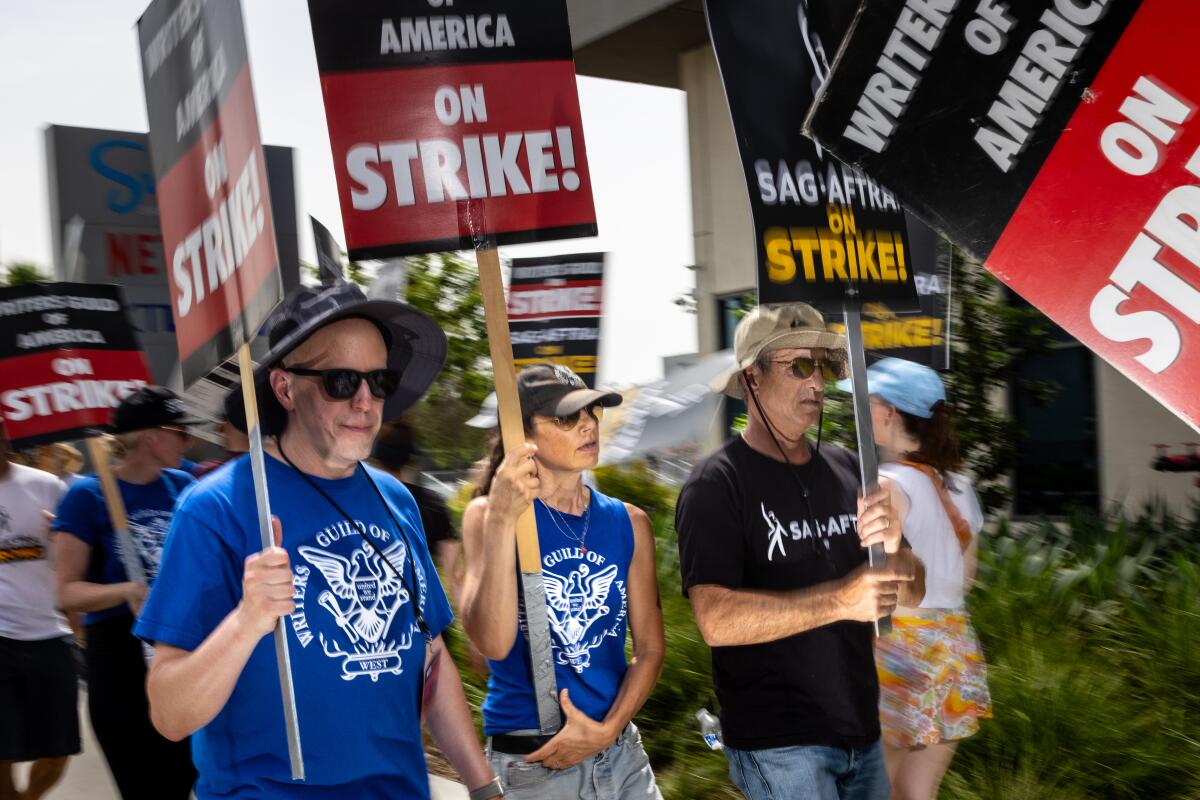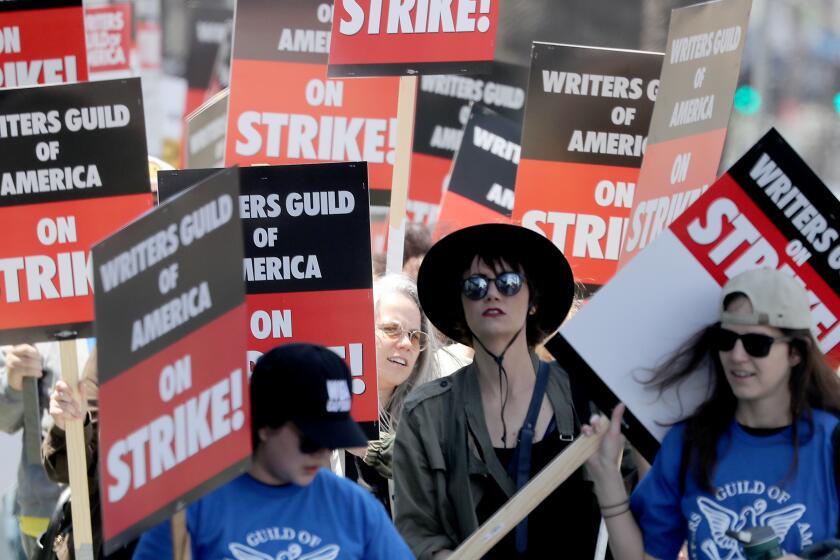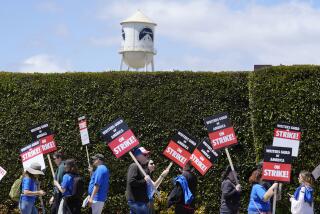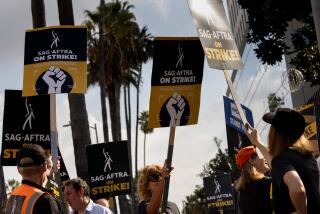Poll: More Americans support striking actors and writers than studios

- Share via
As a bitter labor battle continues to roil Hollywood, the public is paying attention, and Americans are feeling more sympathy toward striking actors and writers than to the studios, networks and streamers, a new poll for the Los Angeles Times finds.
The historic double strike by two of the entertainment industry’s most powerful unions — the Writers Guild of America and SAG-AFTRA — has brought film and TV production to a virtual standstill, generating a high degree of public awareness.
Nearly 3 out of 4 Americans surveyed said they were aware of the strike and 60% said they were at least “somewhat aware” of the issues in the dispute, according to the survey, which was conducted for The Times by Leger, a Canadian-based polling firm with experience in U.S. surveys.
As they weigh those issues, the public generally feels more sympathy toward the actors and writers than the studios, networks and streamers, the Times/Leger poll found.
Thirty-eight percent of respondents say they sympathize more with the striking actors and writers, while just 7% sympathize more with the entertainment and media corporations represented by the Alliance of Motion Picture and Television Producers.
But sympathy for the unions falls short of a majority: Most respondents are either ambivalent or unsure; 29% say they sympathize with both sides equally and 25% said they don’t know which side they favor.
On Friday, WGA negotiators are set to meet with the AMPTP for the first time since the strike began, signaling a possible thaw in the standoff. But with tensions still running high, the industry has been bracing itself for the strikes to last for weeks and possibly months to come, making public sentiment a potentially critical factor as the dispute grinds on.
The acrimonious labor action began May 2 when the 11,500 members of the Writers Guild of America took to the picket lines after contract negotiations with the AMPTP, which represents the studios in labor relations, failed to reach a resolution.
On July 14, 160,000 members of SAG-AFTRA joined writers in the walkout, finding common cause in the fight for better pay and job protections in an industry that has been upended by the rise of streaming.
SAG-AFTRA has approved a deal from the studios to end its historic strike. The actors were on strike for more than 100 days.
Like writers, actors have seen their pay decrease because of shrinking residuals, shorter TV seasons and longer hiatuses. Actors also have raised concerns about the prospect of studios and streamers using their likenesses without their consent thanks to rapid advances in AI.
Studios and streamers have countered that they are facing their own financial headwinds, as the film business struggles to return to its pre-pandemic health and TV viewers continue to abandon network and cable programming in favor of streaming and other digital distractions.
In a statement released last month after talks with SAG-AFTRA broke down, the AMPTP said it had offered “historic pay and residual increases” and “a groundbreaking AI proposal,” adding, “The Union has regrettably chosen a path that will lead to financial hardship for countless thousands of people who depend on the industry.”
As SAG-AFTRA members join writers on picket lines, the fallout will disrupt Hollywood film and TV productions worldwide. ‘There’s going to be blood in the water,’ said one analyst. ‘This will not end well.’
The poll findings reflect not only the high profile of the entertainment industry — which has not seen a joint strike by actors and writers since 1960, when Ronald Reagan was leading the Screen Actors Guild — but also the public’s increasing focus on labor issues generally. In California, the WGA and SAG-AFTRA strikes have come on the heels of walkouts by graduate students, L.A. Unified School District workers and hotel employees, fueling what some are calling “hot labor summer.”
Public support for labor unions has been trending upward in recent years. A Gallup poll conducted last year found that 71% of Americans now approve of labor unions, the highest recorded in Gallup’s annual surveys since 1965.
David Smith, professor of economics at the Pepperdine Graziadio Business School, said the public sympathy toward actors and writers revealed in The Times’ poll is in line with that broader pro-labor shift.
“We’ve seen a continued trend toward an anti-business mentality and more slanted toward the side of the workers, particularly among younger demographics,” Smith says. “For me, this is another data point to support that. If you went back 10 years, I think [sentiment] might have been a little more balanced.”
The public’s feelings about the Hollywood strike to some extent mirror public reaction to other labor disputes in industries where at least some workers are highly paid. Last year, for example, a Los Angeles Times/Survey Monkey poll conducted amid a pre-season Major League Baseball lockout found that 31% of fans blamed the owners for the situation, while only 12% blamed the players and 49% blamed both sides.
That marked a big change from earlier years: During the 1994-95 MLB strike, an NBC/Wall Street Journal poll found that 45% of respondents blamed the players more, while 27% blamed the owners more.
While Hollywood’s A-listers tend to grab the spotlight, the vast majority of SAG-AFTRA members are neither famous nor wealthy. According to SAG-AFTRA, just 12.7% of its members bring in the minimum amount of income — $26,470 — required to qualify for the union’s health insurance.
In a fiery speech last month, SAG-AFTRA President Fran Drescher tied the fate of actors to workers across the economy. “What happens here is important because what’s happening to us is happening across all fields of labor by means of when employers make Wall Street and greed their priority and they forget about the essential contributors that make the machine run.”
Americans divide closely on whether they see actors as ordinary workers or members of a glamorous Hollywood aristocracy. The poll found that 45% view actors in general as “people doing their work like anybody else,” while 38% see them as “part of a privileged elite.”
Perhaps unsurprisingly given the concentration of the entertainment industry in Southern California, those who live in the West are more likely than people elsewhere in the country to see actors as ordinary workers.
Feelings on whether actors are privileged or not are strongly tied to attitudes toward the strike. More than half (55%) of those who see actors as ordinary workers side with the unions, while just 6% side with the companies, the Times/Leger poll found. Among those who see actors as privileged, 30% side with the unions, 59% either sympathize with both sides equally (30%) or don’t know (29%) and 11% side with the companies.
The poll also asked whether people would be willing to pay an extra $1 in the average cost of a movie ticket or a monthly streaming subscription if such price hikes were part of the strike’s resolution. On that question, respondents split evenly, with 39% saying they would be willing to shoulder such a cost while 41% would not.
Younger people are significantly more willing to pay an extra $1, with 58% of those ages 18 to 34 expressing a willingness to pay more. By contrast, 29% of those 55 and older said they would pay more.
Among those who say they regard actors as workers like anyone else, 58% would be willing to pay an extra $1, while 26% would not. The reverse is true of those who see actors as privileged: 25% would be willing to pay more but 62% would not.
The 2023 writers’ strike is over after the Writers Guild of America and the Alliance of Motion Picture and Television Producers reached a deal.
While the last WGA strike in 2007-08, which lasted 100 days, saw union solidarity fracture in Hollywood, the current double strike has the support of the other Hollywood unions, including the Directors Guild of America and the International Alliance of Theatrical Stage Employees, which represents crews, though it’s possible such unity could begin to splinter as the shutdown drags on.
According to Smith, a protracted strike stretching into the fall and beyond could begin to erode public support for actors and writers as well.
“To some extent, there has been a delayed impact on consumers from the work stoppage because there are still shows in the hopper for people to watch,” Smith says. “Over time, I think there could potentially be a little bit of a shift in public opinion away from [striking workers] and a little bit more frustration with them. If they’re still on strike 90 days from now, which seems not a far-fetched possibility, opinions could shift.”
The Times/Leger poll surveyed 1,002 adult Americans between July 28 and 30. The results have an estimated margin of error approximately 3 percentage points in either direction.
More to Read
Inside the business of entertainment
The Wide Shot brings you news, analysis and insights on everything from streaming wars to production — and what it all means for the future.
You may occasionally receive promotional content from the Los Angeles Times.














